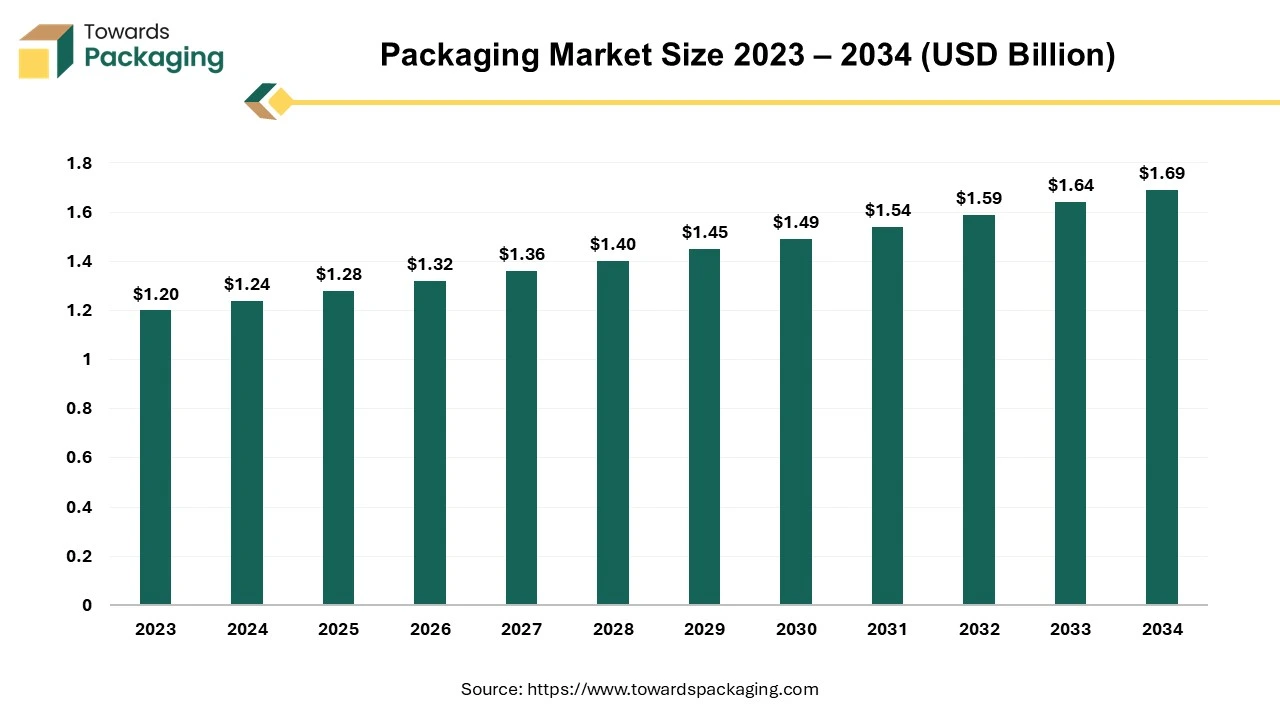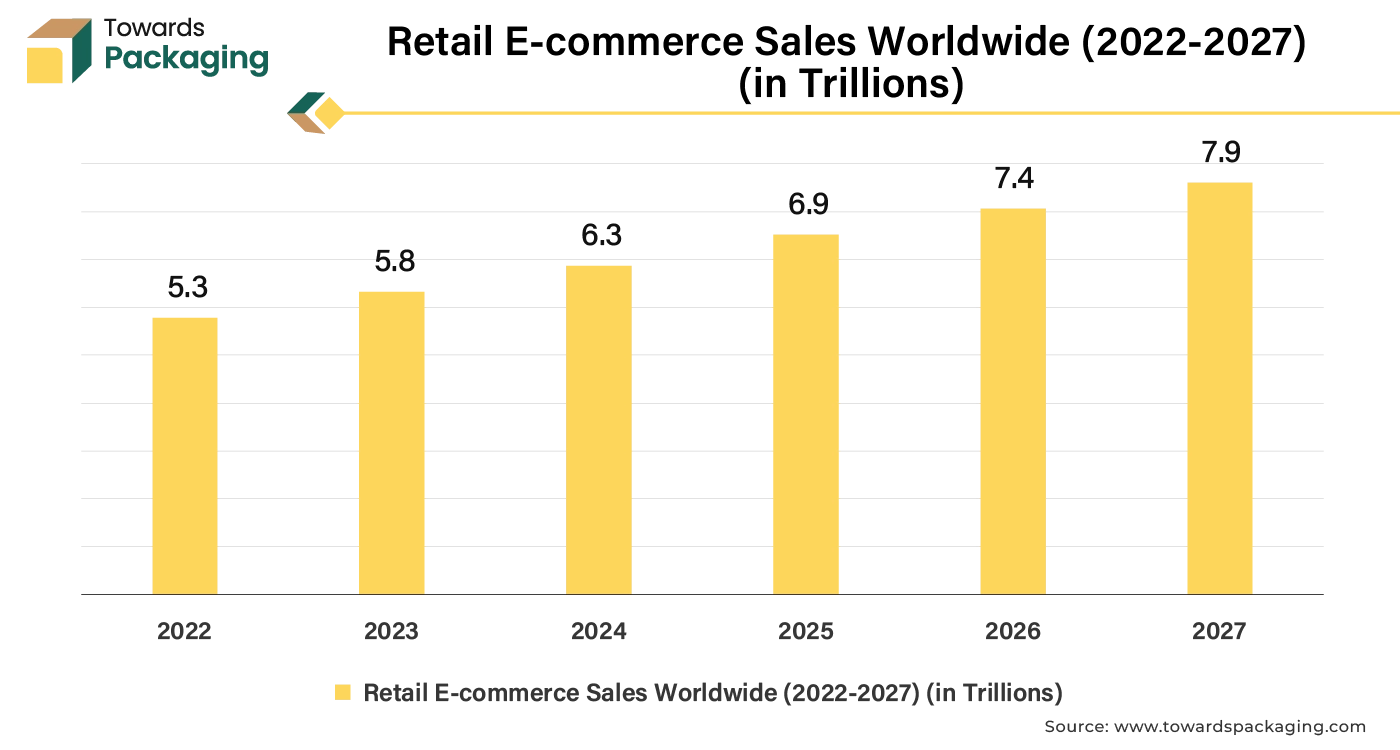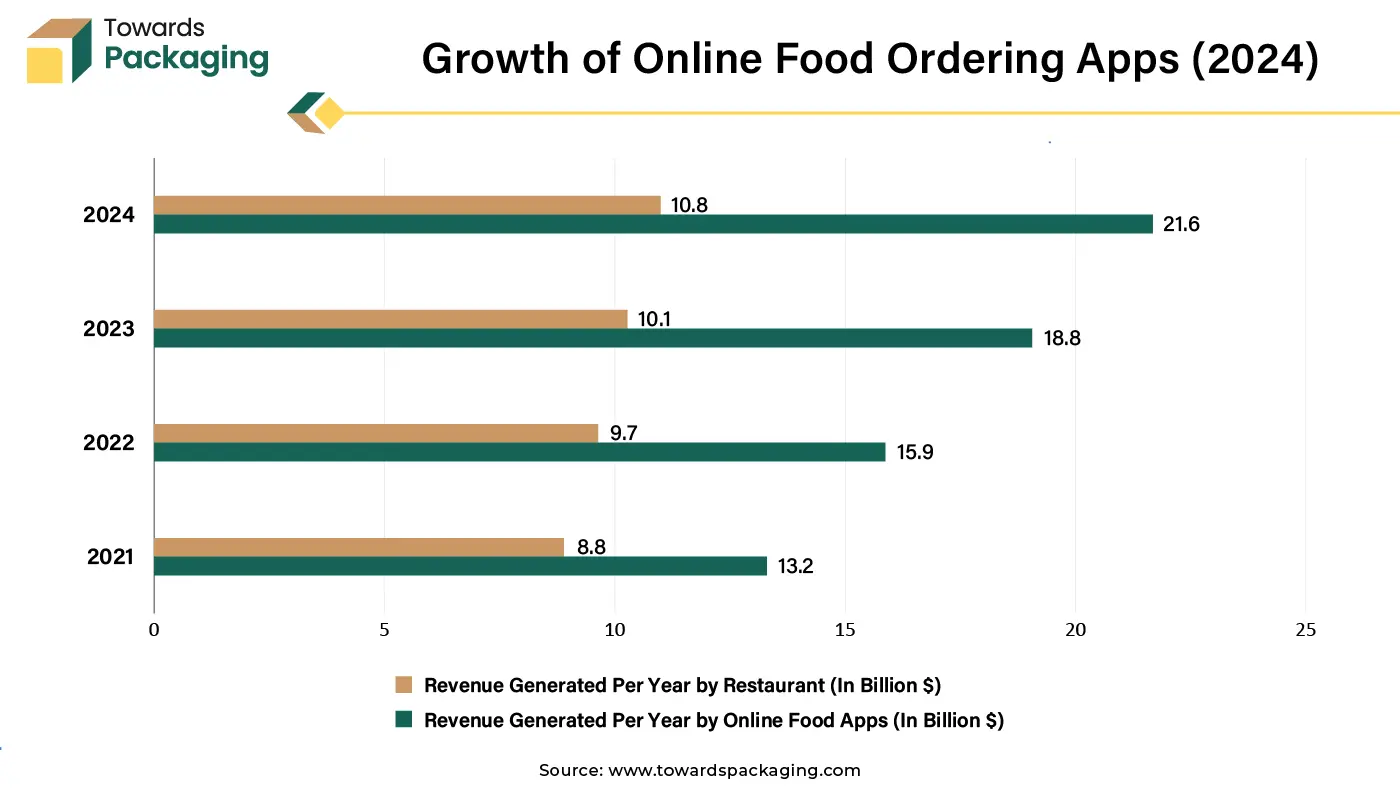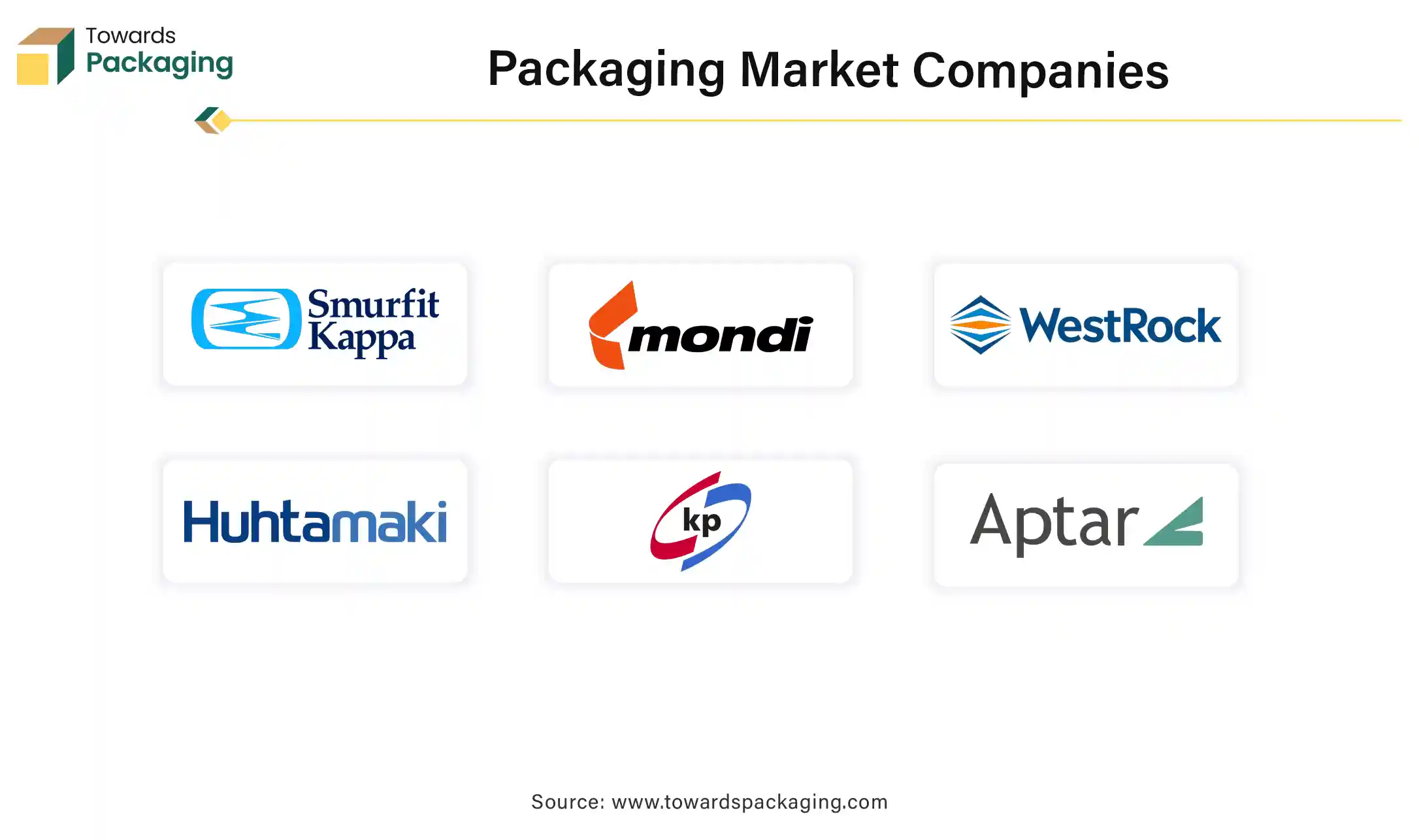March 2025
.webp)
Principal Consultant

Reviewed By
The global packaging market size reached US$ 1.24 trillion in 2024 and is projected to hit around US$ 1.69 trillion by 2034, expanding at a CAGR of 3.16% during the forecast period from 2025 to 2034. The key players operating in the market are focused on adopting inorganic growth strategies like acquisition and merger to develop advance technology for manufacturing plant fiber-based packaging which is estimated to drive the global packaging market over the forecast period.

Packaging is known as the process of designing, evaluating, and producing containers or wrappers for products. It plays a crucial role in protecting goods during storage, distribution, and sale. Packaging not only ensures the product reaches the consumer in good condition but also serves as a marketing tool, communicating brand identity and product information.
Packaging safeguards products from contamination, damage, and tampering during transportation, storage, and handling. It helps in preserving the quality and extending the shelf life of perishable items. Packaging facilitates ease of handling, storage, and usage of the product. It serves as a medium for conveying information such as usage instructions, nutritional information, and branding.
The packaging industry encompasses all businesses and activities involved in the design, production, and distribution of packaging materials and solutions. It is a vital sector in the global economy, supporting various industries like consumer goods, pharmaceuticals, food and beverage, cosmetics, and electronics. There is a significant push towards eco-friendly packaging solutions, including biodegradable materials, recyclable packaging, and minimalistic designs.
Three Eras of Change in Packaging Past, Present and Future |
|||
| Era (Time Periods are Approximate) | Consumer | Packaging Product/ Innovation | Corporate/Value Chain Structure |
| 2000-09 Substrate Shift Changes |
|
|
|
| 2010-20 Changing Face of the Consumer |
|
|
|
| 2020- Sustainability and Digital Transformation |
|
|
|
Era 1: Substrate Shift Changes (2000-2009)
Era 2: Changing Face of the Consumer (2010-2020)
Era 3: Sustainability and Digital Transformation (2020 and Beyond)
AI integration is revolutionizing the packaging market by enhancing efficiency, sustainability, and customer experience. AI can analyze vast amounts of data to develop optimized packaging designs that reduce material usage while maintaining structural integrity. Machine learning algorithms can quickly generate and test multiple design iterations, speeding up the prototyping process.
AI-powered sensors and analytics can predict equipment failures and maintenance needs, minimizing downtime and increasing productivity. Machine learning models can inspect packaging for defects or inconsistencies at high speeds, ensuring consistent quality. AI can recommend alternative, sustainable materials that reduce environmental impact without compromising quality. AI systems can monitor and optimize the use of resources, reducing waste during production and helping achieve sustainability goals. AI systems can monitor and optimize the use of resources, reducing waste during production and helping achieve sustainability goals.
Asia currently accounts for the majority of global packaging sales, owing to the rapid expansion of wealthier middle-class populations in developing countries such as China and India. This population change is followed by increased spending as revenues rise. The expansion of single-member households, an attraction for ready-to-eat meals and smaller container sizes, urbanization, and the increase in online shopping all help drive the growth of the packaging market in Asia. Global patterns in consumption are impacting the packaging business, with the Asia-Pacific area expected to develop at the most rapid pace.
The leaders of this expansion are China and India. The primary consumer of sustainable packaging is the food and beverage industry, promptly followed by the personal care and cosmetics sector. Growing demand for eco-friendly products, increasing customer knowledge of environmental issues, and government programs supporting environmentally friendly packaging practices are all projected to contribute to the resilient development in sustainable packaging that the region of Asia-Pacific is expected to experience.
For Instance,
North America represents the globe's second-largest packaging market. The integrated markets of North America, consisting of the United States, Canada, and Mexico, account for a sizable percentage of the global packaging market. With an estimated revenue of 2,818 million euros in the United States alone by 2025. Though flexible packaging has reached commercial maturity in North America's industrialized nations, the outlook for future development is more muted. The United States appears as one of the fastest-growing packaging markets in the region. This expansion is being accelerated by the presence of major packaging businesses, such Amcor Ltd. and Mondi PLC, among others, which are supporting investments in R&D and innovation.
These companies play an important role in developing unique solutions to the market's different packaging difficulties. Their drive to push the boundaries of packaging technology ensures that the industry evolves indefinitely, fulfilling the ever-changing demands of consumers and businesses. The packaging industry in North America has an opportunity for continued expansion and adjustment owing to the strong foundation these industry leaders have laid. Innovation and appropriate investments will help the industry navigate the constantly shifting terrain of consumer preferences, legal requirements, and technology breakthroughs.
The European packaging market is rapidly expanding, with sustainability and environmental concerns taking primacy in all European countries. 74% of Europeans say that the problem of packaging waste has had a major impact on their purchasing decisions. Among European customers, more over half (52%) actively search out products packaged with eco-friendly materials; this percentage is significantly higher among French shoppers (55%) and Turkish shoppers (56%). Cardboard emerges as the preferred choice for eco-friendly packaging, with 52% of Europeans considering it is the most environmentally friendly material. This perspective is especially prominent in the UK, where 63% of consumers choose this material. Similarly, 45% of Europeans believe cardboard is the most recyclable material, followed by glass (32%). Tins/cans have the lowest perceived recyclability, behind only plastic marginally. The demand for protecting the environment has grown increasingly recognized across Europe.
"Easy to recycle" is ranked as the second preferred packaging feature, with 63% placing it in the top three. This is closely followed by the preference, which is highest among German consumers, for packaging composed of natural or renewable materials. As the European packaging market evolves, sustainable practices and environmentally friendly solutions are anticipated to remain important drivers of consumer preferences and industry developments.
The surge in online shopping has significantly increased the need for robust, protective, and lightweight packaging that can withstand shipping and handling. Consumers seek convenient, easy-to-use packaging solutions, such as resealable pouches, single-serve packages, and ready-to-eat formats. Urbanization and the fast-paced lifestyle of consumers are driving demand for on-the-go and convenience packaging solutions. Rising demand of the packaging due to the growth in the Ecommerce platform has driven the growth of the packaging market over the forecast period.
In January 2025, according to the data published by the National E-commerce Associations, it was estimated that the COVID-19 epidemic has increased the scale of the e-commerce industry and, more than anticipated, its share of overall retail sales. As a result, the pandemic boosted e-commerce's weight in overall retail by 10.61 percent and caused an excess of US$227.820 billion in e-sales, hastening its structural shift. Before 2026, these changes would not have been seen if the pandemic had not occurred.
By 2025, there will be 2.77 billion internet shoppers worldwide. This indicates that 33% of people worldwide shop online. This is a 2.2% rise over the prior year. By 2026, there will be 2.86 billion online shoppers, a statistic that reflects the growth in eCommerce brought on by greater internet accessibility and convenience.

Rising innovation of smart packaging has created lucrative opportunity for the growth of the packaging market. Innovations like RFID tags, IoT-enabled packaging, and augmented reality are improving product tracking, authenticity, and customer engagement. Advanced manufacturing technologies, including AI and robotics, are improving production efficiency, reducing costs, and enabling customization.
The food and beverage sector is a major contributor to the packaging market, driven by demand for safe, hygienic, and attractive packaging. The pharmaceutical industry's growth, especially with the rising need for healthcare products, has led to increased demand for specialized, tamper-proof packaging. Growth in online food ordering has raised the demand for the secured packaging and created lucrative opportunity for the growth of the packaging market in the near future.
In October 2024, according to the data published by the Food Industry Association, it was estimated that Bain & Company and Swiggy, the percentage of Indians who order food online increased from 8% to 12% between 2021 and 2024, which is 3.2 times the growth of online food delivery when compared to total food services. It goes on to say that India's penetration rates are doubled in markets like the US and China.

In 2024, the paper & paperboard market led the packaging market in 2024. Paper and paperboard are highly recyclable, which makes them more environmentally friendly compared to other materials like plastic. As sustainability becomes a growing concern, many companies and consumers are opting for paper-based packaging to reduce their environmental footprint. Paper and paperboard materials are generally less expensive to produce than alternatives like metals, glass, or plastics, which makes them an attractive choice for manufacturers.
As e-commerce continues to expand, the demand for corrugated boxes (a type of paperboard packaging) has surged. These boxes are essential for shipping and ensuring that products arrive safely at their destination. Governments and regulatory bodies worldwide are increasingly implementing policies to reduce plastic waste, which has spurred the shift to paper-based solutions. Many regions are now enforcing bans or restrictions on single-use plastics, and this has further fueled the growth of paper and paperboard packaging.
In 2024, the rigid packaging segment led the market with the largest share. Rigid packaging is highly durable and provides excellent protection for the contents, which is essential for a wide range of products, from food and beverages to pharmaceuticals and electronics. Its sturdiness helps prevent damage during transportation, handling, and storage. Rigid packaging also allows for complex designs, embossing, and color schemes that enhance brand visibility and appeal on retail shelves.
By printing technology, the flexography segment dominated the market. Flexography has become the preferred printing technology for industries such as food and beverage, pharmaceuticals, cosmetics, and consumer goods, all of which rely heavily on high-quality printed packaging. As flexible packaging continues to grow, due to its advantages in terms of lightweight, portability, and convenience, flexography remains the dominant printing method for these materials. Flexible packaging is popular in sectors like food and beverage (e.g., snack bags, beverage pouches), consumer goods (e.g., personal care packaging), and pharmaceuticals.
By end user, the food & beverages segment dominated the packaging market. With a rapidly growing global population and changing consumer lifestyles, there’s an ever-increasing demand for packaged food and drinks. Convenience, portion control, and longer shelf life are key trends that shape packaging needs. Glass bottles, plastic containers, metal cans, and jars are commonly used for beverages, sauces, dairy, and other food products. These materials are essential for preserving the quality and safety of the products.

By Material
By Packaging Type
By Printing Technology
By End User
By Region Covered
March 2025
March 2025
March 2025
March 2025